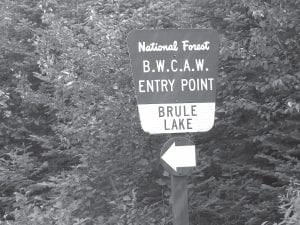Lake County Board of Commissioners Chair Rich Sve recently wrote a strong letter to Rep. Raul Grijalva (D-Arizona) in defense of federal funding for the three counties – Lake, Cook, and St. Louis – that cradle the Boundary Waters Canoe Area Wilderness (BWCAW).
On September 11, 2012, the Cook County Board of Commissioners authorized sending a letter to Grijalva in support of the one Commissioner Sve sent.
Grijalva, on the House Committee on Natural Resources’ Subcommittee on National Parks, Public Lands, and Forests, had written the counties, taking issue with the fact that they have been receiving annual funding for their 1 million acres of Boundary Waters wilderness ever since the Thye-Blatnik Act was passed in 1948 in order to offset the fact that that land can never generate property tax revenue.
The letter from Lake County points out that its tax base is very low because of a small population and an overwhelming majority of land in federal hands—the case with Cook County as well. It quotes from the Thye-Blatnik Act, which states that it was designed “to safeguard and consolidate certain areas of exceptional public value…within Minnesota.”
The letter states, “…Congress concluded that in order to create this eventual million-acre wilderness, some sort of adequate compensation had to be given to the affected counties who would be giving up their current and future ‘priceless’ tax base, forever.
“…There was a clear recognition that the traditional sources of economic activity of this natural-resource-rich region—mining, logging, summer cottages, and motorized recreation opportunities— would now be effectively cut by at least 50 percent, forever.
“…While other regions of America with national parks and federal wilderness areas can at least count on some annual growth in visitors, for the BWCA, the number of visitors is in effect permanently capped at a little over 200,000 visitors. Unfortunately, with an aging population [decreasing] the number of U.S. citizens physically capable of portaging canoes and enduring the elements, this has meant that the annual visitors to the BWCA in recent years has actually been falling. How much? Between 2004-2010, visitor use in the BWCA fell by 12 percent.
“Meanwhile, the 1,000-plus lakes in the BWCA with their tens of thousands of miles of extremely valuable shoreline goes mostly underutilized and significantly underused. Other lakes in our region outside of the BWCA currently have lakeshore selling at anywhere from between $1,000 to $2,000 a running foot. If one were to apply those kinds of numbers to the tens of thousands of miles of shoreline in the BWCA that are forever off the tax rolls, one then realizes the incredible economic sacrifice that the people of our three counties have truly made for the greater good of the entire nation.”
Sve pointed out that the legislation authorizing payment in-lieu-of-taxes (PILT), another county funding source for federal lands (not just wilderness areas), was worded in a way that greatly reduced the funding for the counties that receive Thye-Blatnik payments. He said he noticed that some of the federal land in Grijalva’s state of Arizona was also affected by the PILT law and wondered if the law’s wording created the same “unintended consequence” in his district.
Sve said, “I hope that in the near future, we can refocus and begin to work together to help remove some of the real inequities and unintended consequences that are beginning to develop with the interplay of the existing national PILT law.”



Leave a Reply